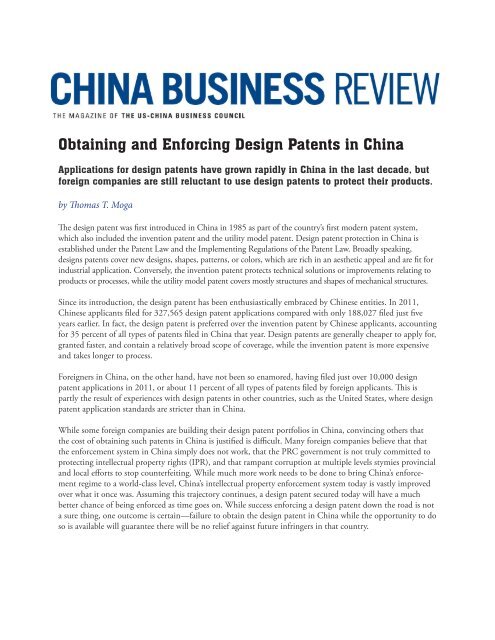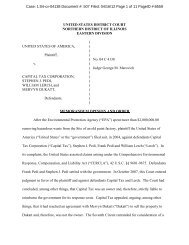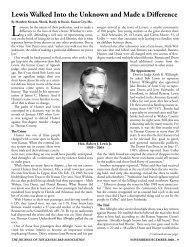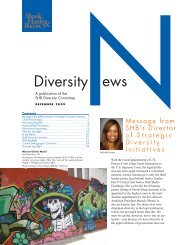Obtaining and Enforcing Design Patents in China - Shook, Hardy ...
Obtaining and Enforcing Design Patents in China - Shook, Hardy ...
Obtaining and Enforcing Design Patents in China - Shook, Hardy ...
Create successful ePaper yourself
Turn your PDF publications into a flip-book with our unique Google optimized e-Paper software.
<strong>Obta<strong>in</strong><strong>in</strong>g</strong> <strong>and</strong> <strong>Enforc<strong>in</strong>g</strong> <strong>Design</strong> <strong>Patents</strong> <strong>in</strong> Ch<strong>in</strong>a<br />
Applications for design patents have grown rapidly <strong>in</strong> Ch<strong>in</strong>a <strong>in</strong> the last decade, but<br />
foreign companies are still reluctant to use design patents to protect their products.<br />
by Thomas T. Moga<br />
The design patent was first <strong>in</strong>troduced <strong>in</strong> Ch<strong>in</strong>a <strong>in</strong> 1985 as part of the country’s first modern patent system,<br />
which also <strong>in</strong>cluded the <strong>in</strong>vention patent <strong>and</strong> the utility model patent. <strong>Design</strong> patent protection <strong>in</strong> Ch<strong>in</strong>a is<br />
established under the Patent Law <strong>and</strong> the Implement<strong>in</strong>g Regulations of the Patent Law. Broadly speak<strong>in</strong>g,<br />
designs patents cover new designs, shapes, patterns, or colors, which are rich <strong>in</strong> an aesthetic appeal <strong>and</strong> are fit for<br />
<strong>in</strong>dustrial application. Conversely, the <strong>in</strong>vention patent protects technical solutions or improvements relat<strong>in</strong>g to<br />
products or processes, while the utility model patent covers mostly structures <strong>and</strong> shapes of mechanical structures.<br />
S<strong>in</strong>ce its <strong>in</strong>troduction, the design patent has been enthusiastically embraced by Ch<strong>in</strong>ese entities. In 2011,<br />
Ch<strong>in</strong>ese applicants filed for 327,565 design patent applications compared with only 188,027 filed just five<br />
years earlier. In fact, the design patent is preferred over the <strong>in</strong>vention patent by Ch<strong>in</strong>ese applicants, account<strong>in</strong>g<br />
for 35 percent of all types of patents filed <strong>in</strong> Ch<strong>in</strong>a that year. <strong>Design</strong> patents are generally cheaper to apply for,<br />
granted faster, <strong>and</strong> conta<strong>in</strong> a relatively broad scope of coverage, while the <strong>in</strong>vention patent is more expensive<br />
<strong>and</strong> takes longer to process.<br />
Foreigners <strong>in</strong> Ch<strong>in</strong>a, on the other h<strong>and</strong>, have not been so enamored, hav<strong>in</strong>g filed just over 10,000 design<br />
patent applications <strong>in</strong> 2011, or about 11 percent of all types of patents filed by foreign applicants. This is<br />
partly the result of experiences with design patents <strong>in</strong> other countries, such as the United States, where design<br />
patent application st<strong>and</strong>ards are stricter than <strong>in</strong> Ch<strong>in</strong>a.<br />
While some foreign companies are build<strong>in</strong>g their design patent portfolios <strong>in</strong> Ch<strong>in</strong>a, conv<strong>in</strong>c<strong>in</strong>g others that<br />
the cost of obta<strong>in</strong><strong>in</strong>g such patents <strong>in</strong> Ch<strong>in</strong>a is justified is difficult. Many foreign companies believe that that<br />
the enforcement system <strong>in</strong> Ch<strong>in</strong>a simply does not work, that the PRC government is not truly committed to<br />
protect<strong>in</strong>g <strong>in</strong>tellectual property rights (IPR), <strong>and</strong> that rampant corruption at multiple levels stymies prov<strong>in</strong>cial<br />
<strong>and</strong> local efforts to stop counterfeit<strong>in</strong>g. While much more work needs to be done to br<strong>in</strong>g Ch<strong>in</strong>a’s enforcement<br />
regime to a world-class level, Ch<strong>in</strong>a’s <strong>in</strong>tellectual property enforcement system today is vastly improved<br />
over what it once was. Assum<strong>in</strong>g this trajectory cont<strong>in</strong>ues, a design patent secured today will have a much<br />
better chance of be<strong>in</strong>g enforced as time goes on. While success enforc<strong>in</strong>g a design patent down the road is not<br />
a sure th<strong>in</strong>g, one outcome is certa<strong>in</strong>—failure to obta<strong>in</strong> the design patent <strong>in</strong> Ch<strong>in</strong>a while the opportunity to do<br />
so is available will guarantee there will be no relief aga<strong>in</strong>st future <strong>in</strong>fr<strong>in</strong>gers <strong>in</strong> that country.
FILING PATENT APPLICATIONS<br />
The design patent application <strong>in</strong> Ch<strong>in</strong>a is a fast, low cost way to obta<strong>in</strong> protection. The design patent application<br />
does not require substantive exam<strong>in</strong>ation, but rather faces only an exam<strong>in</strong>ation as to formalities <strong>in</strong> which<br />
applicant <strong>in</strong>formation, completeness of the application, <strong>and</strong> acceptability of the draw<strong>in</strong>gs are considered.<br />
No comparison with earlier designs is made, although a third party may challenge a patent after it is granted<br />
through a proceed<strong>in</strong>g before the Patent Reexam<strong>in</strong>ation Board (PRB). Time from fil<strong>in</strong>g to grant varies, but<br />
generally is between three <strong>and</strong> eight months. The term of the design patents <strong>in</strong> Ch<strong>in</strong>a is 10 years from the<br />
fil<strong>in</strong>g date. Translation <strong>and</strong> fil<strong>in</strong>g fees are also m<strong>in</strong>imal.<br />
The tim<strong>in</strong>g of fil<strong>in</strong>g is also important. Ch<strong>in</strong>a is a first-to-file country, so whoever gets to the patent office first<br />
with the application generally w<strong>in</strong>s. Foreign applicants can overcome this disadvantage by fil<strong>in</strong>g early <strong>in</strong> their<br />
home country followed by a timely fil<strong>in</strong>g <strong>in</strong> Ch<strong>in</strong>a. Failure to file first can result <strong>in</strong> lost design patent rights.<br />
The date of fil<strong>in</strong>g is also important as Ch<strong>in</strong>a is an “absolute novelty” country, mean<strong>in</strong>g that the “prior design”<br />
that can be cited aga<strong>in</strong>st the application <strong>in</strong>cludes “any design known to the public <strong>in</strong> this country or abroad<br />
before the date of fil<strong>in</strong>g.” Accord<strong>in</strong>gly, all applicants seek<strong>in</strong>g design patent protection <strong>in</strong> Ch<strong>in</strong>a need to file a<br />
patent application somewhere <strong>in</strong> the world before the design is known publicly, either <strong>in</strong>side or outside Ch<strong>in</strong>a.<br />
APPLICATION CHALLENGES<br />
In the eyes of patent counsel of a major US sport shoe maker who has been “reasonably impressed” with the<br />
quality of patent exam<strong>in</strong>ation, deal<strong>in</strong>g with Ch<strong>in</strong>a’s draw<strong>in</strong>g practice has been the greatest challenge <strong>in</strong> obta<strong>in</strong><strong>in</strong>g<br />
design patents. In his company, harmonization of draw<strong>in</strong>g practices has been difficult—<strong>and</strong> costly—to develop.<br />
Foreign applicants frequently f<strong>in</strong>d that the draw<strong>in</strong>gs they submit to other patent offices, such as the US Patent<br />
<strong>and</strong> Trademark Office (USPTO), may not be acceptable to Ch<strong>in</strong>a’s State Intellectual Property Office (SIPO)<br />
without changes, such as remov<strong>in</strong>g surface shad<strong>in</strong>g or broken l<strong>in</strong>es.<br />
<strong>Design</strong> patent applications <strong>in</strong> Ch<strong>in</strong>a also require the applicant to provide a brief description that “may be used<br />
to expla<strong>in</strong> the said design as shown <strong>in</strong> the draw<strong>in</strong>gs or pictures.” Initially, applicants worried that the written<br />
description could be used by a court to <strong>in</strong>terpret the scope of the patent. However, experience has demonstrated<br />
that a general statement identify<strong>in</strong>g the “essential portion” of the design as be<strong>in</strong>g “the shape of the product<br />
of the design” would be acceptable to SIPO.<br />
<strong>Design</strong> patents can overlap with copyright protection <strong>in</strong> Ch<strong>in</strong>a. Currently, works of “applied art” (def<strong>in</strong>ed as<br />
“artistic works with utilitarian functions”) are eligible for copyright protection <strong>in</strong> Ch<strong>in</strong>a, but only to foreign<br />
applicants. Products such as sneakers, tire treads, <strong>and</strong> even Lego bricks may be eligible for copyright protection<br />
<strong>in</strong> Ch<strong>in</strong>a as “works of applied art.” In March 2012, the National Copyright Adm<strong>in</strong>istration of Ch<strong>in</strong>a<br />
issued a draft of proposed amendments to Ch<strong>in</strong>a’s Copyright Law, which remedies the current law by mak<strong>in</strong>g<br />
copyright protection for works of “applied art” available to both domestic <strong>and</strong> foreign parties.<br />
THE QUESTION OF FUNCTIONALITY<br />
Under the Patent Law, patented designs must be dist<strong>in</strong>ctly different from exist<strong>in</strong>g designs or the comb<strong>in</strong>ations<br />
of the features of exist<strong>in</strong>g designs <strong>and</strong> must not be <strong>in</strong> conflict with the lawful rights acquired by others prior to<br />
the date of application. But there is an ongo<strong>in</strong>g debate <strong>in</strong> Ch<strong>in</strong>a about how much functionality a design patent<br />
can have <strong>in</strong> Ch<strong>in</strong>a before it falls outside the scope of design protection. For example, vehicle components,<br />
<strong>in</strong>clud<strong>in</strong>g exhaust systems, have been patented as designs <strong>in</strong> Ch<strong>in</strong>a, even though these items would not receive<br />
design patent protection <strong>in</strong> the United States.
Because design patents protect designs of <strong>in</strong>dustrial products, most of these products have specific functions.<br />
No design patent has been <strong>in</strong>validated by the PRB merely because it was “functional.” At present, the criteria<br />
for determ<strong>in</strong><strong>in</strong>g the patentability of a product under design patent <strong>in</strong> Ch<strong>in</strong>a is whether or not the article is<br />
identical with or similar to any prior design. As it st<strong>and</strong>s today, the system <strong>in</strong> Ch<strong>in</strong>a allows the applicant to<br />
obta<strong>in</strong> a broader scope of design patent protection than is available <strong>in</strong> most other countries.<br />
ENFORCEMENT<br />
Ch<strong>in</strong>a has experienced significant growth <strong>in</strong> the number of filed patent applications over the last 10 years.<br />
In 2001, 203,573 patent applications were filed, of which 60,647 were for designs. In 2011, more than<br />
1 million patent applications were filed, of which 337,796 were for designs. Patent litigation <strong>in</strong> Ch<strong>in</strong>a has<br />
kept pace, mak<strong>in</strong>g Ch<strong>in</strong>a today the most litigious country <strong>in</strong> the world when it comes to <strong>in</strong>tellectual property<br />
enforcement. In 2001, only 1,597 <strong>in</strong>fr<strong>in</strong>gement actions had been filed. By 2010, that number had risen to<br />
5,700, compared with 3,605 patent <strong>in</strong>fr<strong>in</strong>gement actions filed <strong>in</strong> the United States <strong>in</strong> the same year.<br />
Over the past couple of years, PRC courts have witnessed noteworthy <strong>in</strong>fr<strong>in</strong>gement actions that <strong>in</strong>volved<br />
design patents, but it is still unclear how similar an accused product has to be before it is found to be<br />
<strong>in</strong>fr<strong>in</strong>g<strong>in</strong>g. In an effort to provide guidance to courts wrestl<strong>in</strong>g with this question, the Supreme People’s Court<br />
issued an <strong>in</strong>terpretation <strong>in</strong> January 2010 specify<strong>in</strong>g that <strong>in</strong> determ<strong>in</strong><strong>in</strong>g <strong>in</strong>fr<strong>in</strong>gement an “eye of the ord<strong>in</strong>ary<br />
beholder” test will be applied to determ<strong>in</strong>e whether or not there is substantial similarity. This same “ord<strong>in</strong>ary<br />
beholder” must undertake a “comprehensive assessment” of the overall configurations of the compet<strong>in</strong>g<br />
designs when determ<strong>in</strong><strong>in</strong>g whether or not there is sufficient identity to support a f<strong>in</strong>d<strong>in</strong>g of <strong>in</strong>fr<strong>in</strong>gement.<br />
However, previous court decisions suggest that treatment of identity by Ch<strong>in</strong>ese courts rema<strong>in</strong>s <strong>in</strong>consistent<br />
<strong>and</strong> contradictory.<br />
In 2003, Honda brought a case aga<strong>in</strong>st Ch<strong>in</strong>ese auto maker Heibei Shuanghuan alleg<strong>in</strong>g that the Ch<strong>in</strong>ese<br />
automakers “Laibao S-RV” <strong>in</strong>fr<strong>in</strong>ged its design patent for the C-RV. The case ultimately made its way to the<br />
Supreme People’s Court. Honda’s patent was challenged by defendant Heibei, which claimed that the C-RV<br />
design was known <strong>and</strong> was thus shown <strong>in</strong> the “prior art” before Honda applied for patent protection.<br />
The court determ<strong>in</strong>ed that, at least with sedans, a review of the overall view of the vehicle does not help<br />
because sedans have common configurations. In such case, the “ord<strong>in</strong>ary consumer” is able to dist<strong>in</strong>guish<br />
between particular products by dist<strong>in</strong>guishable features, such as headlamps. Certa<strong>in</strong> design features were used<br />
to determ<strong>in</strong>e br<strong>and</strong> identity, at least with sedans.<br />
In 2009, German company Neoplan Bus won more than $3 million <strong>in</strong> damages after br<strong>in</strong>g<strong>in</strong>g a design patent<br />
case aga<strong>in</strong>st Ch<strong>in</strong>ese auto maker Beij<strong>in</strong>g Zhongtong X<strong>in</strong>ghua. The First Intermediate People’s Court of Beij<strong>in</strong>g<br />
found that there had been <strong>in</strong>fr<strong>in</strong>gement of a bus design. In rul<strong>in</strong>g <strong>in</strong> favor of Neoplan, the court ignored<br />
“partial <strong>and</strong> m<strong>in</strong>or” differences that did not impact the overall design of the bus. The court may have come to<br />
a different conclusion than the Honda case because a bus is a “less common article” than a sedan.<br />
The director of <strong>in</strong>tellectual property for a US-based global manufacturer of footwear <strong>and</strong> athletic apparel<br />
says he hesitates to obta<strong>in</strong> more design patents <strong>in</strong> Ch<strong>in</strong>a because of the <strong>in</strong>consistency <strong>in</strong> court decisions <strong>and</strong><br />
because even a slight difference between the design patent <strong>and</strong> the product results <strong>in</strong> a f<strong>in</strong>d<strong>in</strong>g of non-<strong>in</strong>fr<strong>in</strong>gement.<br />
He says his company enforces its trademarks <strong>in</strong> Ch<strong>in</strong>a so it does not hesitate to enforce its IPR <strong>in</strong><br />
general, but he believes the narrow <strong>in</strong>terpretation of the scope of design coverage demonstrated by the courts<br />
outweighs the value of design patents. But he says he does not have plans to ramp up his modest design patent<br />
portfolio given the unsettled state of design patent <strong>in</strong>terpretation by the Ch<strong>in</strong>ese courts.
HOW THE SYSTEM IS FAILING<br />
While Ch<strong>in</strong>a’s patent laws today are world-class, the challenges <strong>in</strong>volved <strong>in</strong> enforcement rema<strong>in</strong> considerable.<br />
This fact, coupled with rampant <strong>in</strong>fr<strong>in</strong>gement, forces many prospective foreign design patent applicants to<br />
re-consider <strong>and</strong> frequently ab<strong>and</strong>on plans to file many (or any) design patent applications <strong>in</strong> Ch<strong>in</strong>a.<br />
Patent coverage must be exp<strong>and</strong>ed<br />
In Ch<strong>in</strong>a, design protection is directed to physical objects <strong>and</strong> excludes products with graphical user <strong>in</strong>terface<br />
(GUI) from design patent protection. The GUIs, such as icons, menus, <strong>and</strong> po<strong>in</strong>t<strong>in</strong>g devices, allow humans to<br />
<strong>in</strong>teract with their computers <strong>and</strong> cell phones. However, Ch<strong>in</strong>a now has the opportunity to jo<strong>in</strong> the majority<br />
of countries that grant design patent protection for GUIs. David Kappos, undersecretary of Commerce<br />
for Intellectual Property <strong>and</strong> director of the USPTO, stated that “design protection of GUIs is important <strong>in</strong><br />
address<strong>in</strong>g the <strong>in</strong>creas<strong>in</strong>g phenomenon of migration of real objects to virtual objects, such as cell phones or<br />
laptops, or the GUI of a refrigerator to enable its remote control. There is also a need to provide more robust<br />
protection for designs <strong>in</strong> the borderless comput<strong>in</strong>g ‘cloud.’”<br />
“Junk” patents fil<strong>in</strong>gs must be policed<br />
Because the system of grant<strong>in</strong>g design patents does not require SIPO to undertake a substantive exam<strong>in</strong>ation,<br />
the fil<strong>in</strong>g of frivolous design patent applications is common. The result<strong>in</strong>g “junk” patents are either based<br />
on previously known designs or issued design patents with or without m<strong>in</strong>or modifications. For example, a<br />
licensee of a design patent re-submitted the same design <strong>in</strong> his own design patent to “double” <strong>and</strong> thereby<br />
“improve” the rights of the legitimate design patent holder—all without the authorization of the licensor.<br />
To reduce the number of junk patents, Ch<strong>in</strong>a could adopt a system of substantive exam<strong>in</strong>ation. This step<br />
would be consistent with Ch<strong>in</strong>a’s push for <strong>in</strong>creased domestic <strong>in</strong>novation. Other possible modifications <strong>in</strong>clude<br />
the requirement that an oath or declaration attest<strong>in</strong>g to orig<strong>in</strong>ality of the design be submitted with the<br />
application (currently not required) or the requirement of a SIPO-issued evaluation report prior to the fil<strong>in</strong>g<br />
of an <strong>in</strong>fr<strong>in</strong>gement action. Along these l<strong>in</strong>es, penalties for know<strong>in</strong>gly assert<strong>in</strong>g an <strong>in</strong>valid design patent should<br />
be levied. A separate opposition proceed<strong>in</strong>g should also be established for design patents.<br />
Encourage more flexibility <strong>in</strong> <strong>in</strong>fr<strong>in</strong>gement cases<br />
A more flexible approach to <strong>in</strong>terpret<strong>in</strong>g the identity of a design patent would make use of the system <strong>in</strong><br />
Ch<strong>in</strong>a more attractive to foreign applicants. It would also make the system fairer to all design patent holders who<br />
engage <strong>in</strong> <strong>in</strong>fr<strong>in</strong>gement litigation. For example, <strong>in</strong> the United States, a product <strong>in</strong>fr<strong>in</strong>ges a patented design<br />
when “<strong>in</strong> the eye of an ord<strong>in</strong>ary observer, giv<strong>in</strong>g such attention as a purchaser usually gives, [the] two designs<br />
are substantially the same ... the resemblance [be<strong>in</strong>g] such as to deceive such an observer, <strong>in</strong>duc<strong>in</strong>g him to purchase<br />
one suppos<strong>in</strong>g it to be the other.” The ord<strong>in</strong>ary observer is deemed to view the differences between the<br />
accused product <strong>and</strong> the patented design <strong>in</strong> the context of prior art, such that differences between the claimed<br />
design <strong>and</strong> the prior art are likely to be relevant. (However, there is no separate explicit requirement that the<br />
accused product appropriate the novelty of the patented design.)<br />
The design patent <strong>in</strong> Ch<strong>in</strong>a is underutilized by foreign companies, but it is a valuable tool that can both<br />
protect <strong>in</strong>vestment <strong>and</strong> potentially halt <strong>in</strong>fr<strong>in</strong>gement. Ch<strong>in</strong>a has taken several positive steps to improve its<br />
design patent protection, at least on paper. However, a susta<strong>in</strong>ed <strong>and</strong> focused effort to halt rampant counterfeit<strong>in</strong>g<br />
<strong>and</strong> to overcome <strong>in</strong>adequate enforcement by broaden<strong>in</strong>g the scope of design patent coverage will be<br />
required if Ch<strong>in</strong>a’s IP system is embraced without reservation by the <strong>in</strong>ternational patent community.<br />
Thomas T. Moga (tmoga@shb.com) is a partner at <strong>Shook</strong>, <strong>Hardy</strong> <strong>and</strong> Bacon L.L.P. <strong>in</strong> Wash<strong>in</strong>gton, D.C.,<br />
<strong>and</strong> is registered to practice before the US Patent <strong>and</strong> Trademark office.










